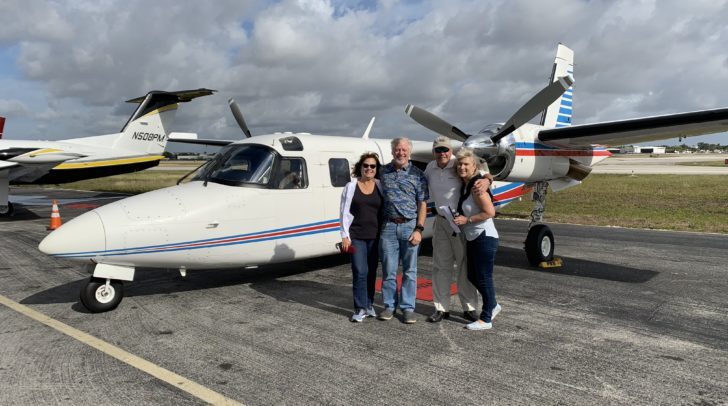By Guillaume Fabry

In February a customer decided to fly his Turbo Commander from Florida to Panama and Ecuador, heading for the Galapagos Islands on an Air Journey trip to South America. We departed from Fort Lauderdale, Florida, heading first to Panama for a couple of nights, then over to Guayaquil, Ecuador, where we launched commercial to the Galapagos Islands. Yes, commercial, because the archipelago is located 620 nautical miles away from the mainland. No fuel is available on the islands, parking is very limited due to construction, and there is no alternate en route.


The Galapagos Islands are known to be one of the best wildlife-viewing locations in the world. Its diversities in water- and land-animal species are incredible and many are found nowhere else on Earth. To get to the Galapagos, one has to fly to Ecuador first via a choice of routes, such as the Caribbean or Central America. For us leaving out of Florida, the options were to fly to Cayman, Jamaica, or the Dominican Republic for a fuel stop as those are friendly and easy fuel stops. Once you get to the north coast of South America, Air Journey uses Panama City, Panama, or Cartagena, Colombia, for a stop for a few nights. Both are amazing destinations to get introduced to the Spanish culture.
Make sure the United States eAPIS is filed when leaving the country, the Caricom eAPIS is filed for Cayman and Jamaica, and you have a landing permit approved by the civil aviation of Panama for landing there. Colombia generally requires a landing permit if you fly a private plane to Colombia, but no permit is necessary if you stay less than 48 hours and you make only one stop in Colombia. For planes requiring a fuel stop in southern Colombia, you will need a Colombian permit because of a domestic leg. Cali, in the coffee region, is a good fuel stop in southern Colombia.
On this journey we had scheduled to leave Fort Lauderdale Executive for Panama City. The flight is about 1,050 nautical miles along airways with an overflight of Cuba (overflight permit required). It was an easy 3.5-hour flight for our Dash 10-powered Commander.
The approach in Panama is very interesting as you get vectored into a right downwind for Runway 01 at Panama Gelabert Airport. That vectoring gives you an amazing view over the Panama Canal. You can see the old locks, the new locks and all the huge ships waiting for their turn to get in. On the left hand side, you can enjoy a nice view of the old colonial city of Panama and the new city with all the new high rises. ATC usually ask if you are familiar with the field, as the military airport of Panama is located just on the other side of the canal, with a longer runway, and can be easily spotted before the general aviation airport of Gelabert. Needless to say, multiple pilots have landed at the military airport thinking they were landing at the GA airport We spent a couple of nights in Panama and enjoyed a tour of the Canal and the new and old city.
Our next route was straight south from Panama to Guayaquil, Ecuador. This flight was mainly over water (660 nautical miles total) with the first third of the flight in Panama airspace, then Colombia airspace (overflight permit required), then into Ecuador.
As we headed south into Ecuadorian airspace, we passed the equator southbound. Normally, the game is to be able to take a picture of the coordinates on the Garmin GPS switching from N000.00.01 to S00.0.001 which is not easy to do at 300 knots. The first time you wonder if anything different will happen with the instruments once passing the equator. Will things start turning the other way as we are now in the Southern Hemisphere? Fortunately, the answer is no; everything keeps running smoothly and the flight continued as planned. As we got closer to Guayaquil we studied the several STARs published, but ended up getting vectors for the ILS X Runway 21.

Typically, weather there in February and March is a layer of broken clouds at 2000 feet and another broken layer at 8000 feet with some light rain showers in the afternoon. While flying the approach you can enjoy looking out and seeing the city. Once on the ground, parking is normally on the cargo ramp. There’s no full-size FBO but handlers will meet you at the airplane, get a fuel truck and take you to the general aviation terminal to clear customs and immigration.

Only four airports in Ecuador are international airports—SEGU Guayaquil, SEMT Manta, SEQM Quito at 9,500 feet of elevation, and SELT Latacunga located about a 90-minute drive south of Quito in the mountains. Our destination was Guayaquil because they have nonstop commercial flights to the Galapagos. I wish we could have flown our Turbo Commander there, but we would have needed to fly 620 nautical miles twice, with two takeoffs and two landings, with no alternate along the way.
The Galapagos is a once-in-a-lifetime, must-visit place. It’s the land of evolution.
Air Journey runs the Galapagos trip twice a year in February and March to ensure the best possible weather along the way.








